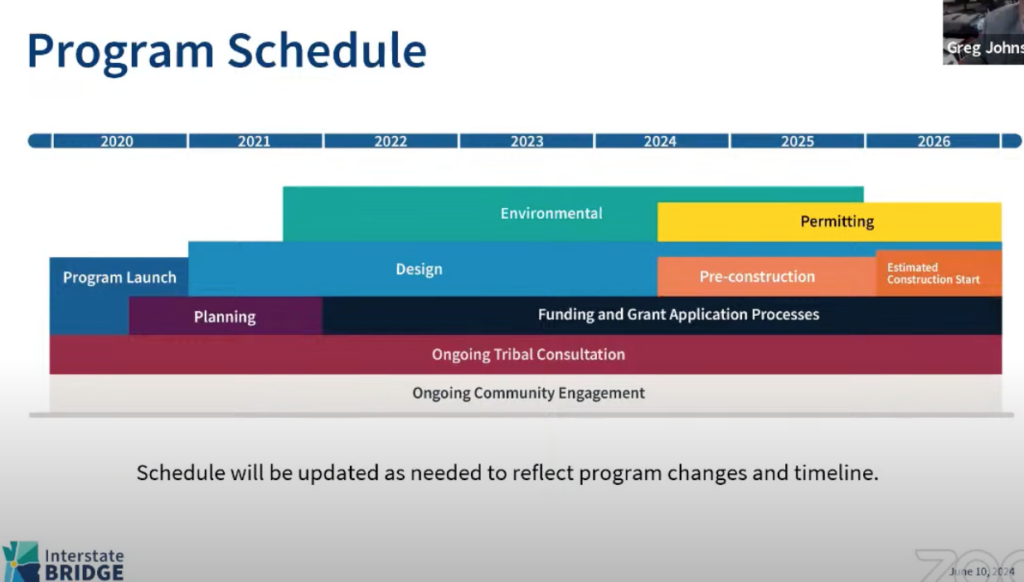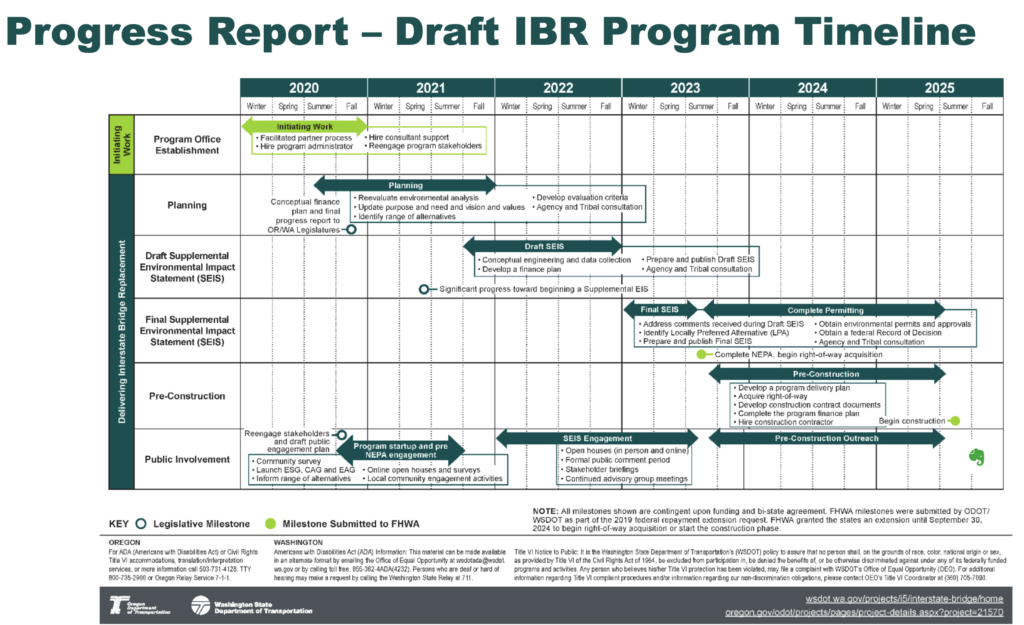The $7.5 billion Interstate Bridge Replacement Project (IBR) is likely delayed up to 18 months because of flawed traffic modeling. The Oregon and Washington DOTs are in denial about the problem, but previously secret records obtained by City Observatory show ODOT and WSDOT have long known that traffic modeling needed to be fixed, and put off doing so, in an attempt to publish its long delayed Draft Supplemental Environmental Impact Statement before Metro adopted a new Regional Transportation Plan (which would require new modeling).
- The Issue: IBR’s traffic modeling is outdated and needs to be redone to satisfy the US Department of Transportation and also to comply with Metro’s recently adopted Regional Transportation Plan (RTP).
- IBR Knew About the Risk: Internal documents show IBR was aware of this potential delay for years but hoped to avoid it by rushing the environmental review process.
- Delays Confirmed: IBR now acknowledges the need to redo the modeling, causing delays of 6 to 18 months according to their own previously secret risk reports.
- Downplaying the Problem: Despite the delays, ODOT officials downplay the issue, vaguely claiming that they are “On track to . . a good path to get this project underway.”
- Transparency Concerns: IBR hasn’t released an updated project schedule reflecting the delays. The current schedule, from January 2024, is already outdated.
- Potential Project Reassessment: The new modeling is likely to show lower traffic needs, potentially impacting the project’s justification, size, and environmental assessments.
For years, City Observatory and others have pointed out fundamental flaws in the IBR traffic modeling. Models used by IBR systematically over-estimate both current and future levels of traffic on the I-5 bridge, painting a distorted picture of both the need for the project and its environmental effects. In short, traffic modeling is not a mere technical detail, its the foundation of the entire project, from its “purpose and need” statement that assumes unrealistic rates of traffic growth, to its financial analysis that assumes that tolls will cover a significant portion of project costs, to its claims that the project won’t increase pollution and greenhouse gas emissions, or cause massive traffic diversion to I-205. If IBR’s traffic modeling is wrong, the entire project rests on a flawed foundation.
IBR officials mis-state and conceal project delay in legislative testimony
At a June 10 hearing of the Joint Oregon and and Washington legislative committee charged with overseeing the project, Project Director Greg Johnson conceded that IBR was having to re-do the project’s traffic modeling because it over-estimated traffic and transit ridership:
The Federal Transit and Federal Highway Administration believes that some models across the country have been over predicting ridership, and we have to resolve that issue. And so that was the reason for the delay:
Johnson, prompted by the project’s Legislative cheerleader, Oregon Rep. Susan McLain, tried to downplay the significance of the delay
REP. MCLEAN: Okay, so this is normal stuff. We’re still on on . . . basically we’re one or two months slowed down, but we’re still on line to get construction started in 2025 with all of the things that you’ve presented today, as far as getting our work done on our permits, etc, correct?
GREG JOHNSON: Yes, we are still on track to uhhh . . . we’re moving some things around, and you’ll see a presentation later about our proposed delivery process that we put forward to the industry to get input on. We are, we are on a good path to get this project underway.
Johnson’s reply is notable principally for its vagueness. “On track to . . a good path to get this project underway.”
Secret documents show new projections will produce up to 18 months of delay
The project’s own detailed project schedule and risk analysis reports–conspicuously not provided to the Legislative Committees by IBR–tell a very different story. The risk analysis has been warning that the traffic modeling would likely need to be re-done for the past couple of years. And now that risk has materialized
The IBR’s own quarterly risk update, which City Observatory obtained under public records law, shows that the project will be delayed by up to a year and a half in order to fix the problem with the traffic projections. Risk #185, a need to change travel demand modeling, is featured prominently in the latest (April 2024) quarterly risk update.

Let’s translate: “the risk is currently being realized” means “this bad thing, which we hoped wouldn’t happen, is actually now happening.” The “schedule impact range was increased” means, “we thought the need to redo modeling would add only 1-3 months to the time needed to complete the SDEIS, but now it will add at least 6 months and as much as 18 months.
The quarterly risk summary is a little obscure. IBR’s “Risk Register” provides a bit more detail:
Risk #185: Changes to Travel Demand Modeling Parameters
Changes to current travel demand modeling parameters (2045 time period) or changes to model standard practices lead to a new model runs required; pre-ROD leads to delays. Land use changes in the program year may trigger additional analysis (i.e., Hayden Island).
Ensure that incorporation of travel analysis numbers is not required at the DSEIS.
Continue to track policy changes that may impact travel demand modeling requirements.
Plan for updated Metro RTP model in 2023.
Confirm with RTC on cross river land use and forecast.
If changes could result in delays, do not use them.
The language of the risk register is terse and bureaucratic, but the key facts are these.
- IBR traffic modeling is based on the Metro Regional Travel Demand Model.
- Metro adopted changes to its Regional Transportation Plan in November, 2023, and these changes involve significant changes to the model’s parameters (assumptions about future traffic growth).
- IBR is having to re-do its traffic modeling to be consistent with the new Metro modeling structure.
- IBR has known about this risk for a long time, and was hoping to avoid this by releasing the Draft SEIS before Metro adopted its new RTP.
- IBR’s risk report now says this will add 6 to 18 months delay to the IBR project.
We currently don’t know how delayed the project is because IBR hasn’t completed a new project schedule since January. That schedule claimed the Draft Supplemental EIS would be released in April. No new schedule has been prepared since then to incorporate these changes. As a result of these delays, the IBR is now at least two years behind the schedule it announced in December 2020, meaning that the environmental review process will have taken at least twice as long–four years, rather than the two years it claimed then.
IBR: Already two years behind schedule, more delays coming
Anyone who looks closely at the meeting materials can see that IBR is already laying the groundwork for the bad news that the project is falling even further behind schedule. Look at the schedule timeline: Unlike previous schedules provided to the committee in earlier hearings, this one doesn’t show actual milestones, and years aren’t broken into quarters. Its much more ambiguous about when anything will be actually done. It shows the enviironmental work (a green line) extending through all of calendar 2024, and contrary to Rep. McLain’s statement, construction not starting until sometime in 2026. And the entire chart comes with a “don’t believe any of this” disclaimer: “Schedule will be updated as needed to reflect program changes a timeline.” Translation: We know this is wrong and its going to take longer than we’ve shown here.
For comparison, here is the schedule that IBR presented to the same committee three and a half years ago, in December 2020. As you can see, although less colorful, the earlier schedule was more detailed (quarterly), more precise (with descriptions and milestones) and called for the draft SEIS to have been released by the end of 2022.
The delay is substantial–IBR’s own estimate is as much as 18 months. It was anticipated and avoidable: IBR knew that Metro’s RTP adoption would lead to important model changes that would affect the SDEIS. Greg Johnson’s slippery statements “On track to uhhhh . . a good path to get this project underway” and IBR’s sweeping caveat “Schedule will be updated” show that they’re just trying to downplay the delays.
New traffic modeling could require major project changes
Finally, we have yet to see the new modeling work. We can be virtually certain that it will be significantly different than what IBR has published so far: if the differences were likely to be minor, the Federal Highway Administration would not have made an issue of the projections. The new projections will show far lower levels of traffic using an I-5 bridge, meaning that the project’s purpose and need is wrong, its justification for a massive widening is wrong, and is assessments of environmental effects are wrong as well. Lower traffic numbers will also reduce estimates of future toll revenue. All this confirms points that City Observatory and other observers have been making for years: this project is founded on exaggerated traffic projections. The substance of the changes dictated by different–and lower–traffic projections, will likely lead to further delays.
Previously Secret Documents, IBR withheld from Legislative Oversight Committee
Because they were not made public record by the IBR team at the June 10, 2024, Joint Oregon-Washington Legislative Oversight Committee meeting, City Observatory provided these documents for the official record, and is also posting them here for the public to see.
Quarterly Risk Update
[pdf-embedder url=”https://cityobservatory.org/wp-content/uploads/2024/06/IBR_Q1_2024_Quarterly_Update_Memo___RR.pdf”]
Project Schedule
[pdf-embedder url=”https://cityobservatory.org/wp-content/uploads/2024/06/2023-04-REQUEST-FULL-schedule.pdf” title=”2023-04 REQUEST FULL schedule”]



